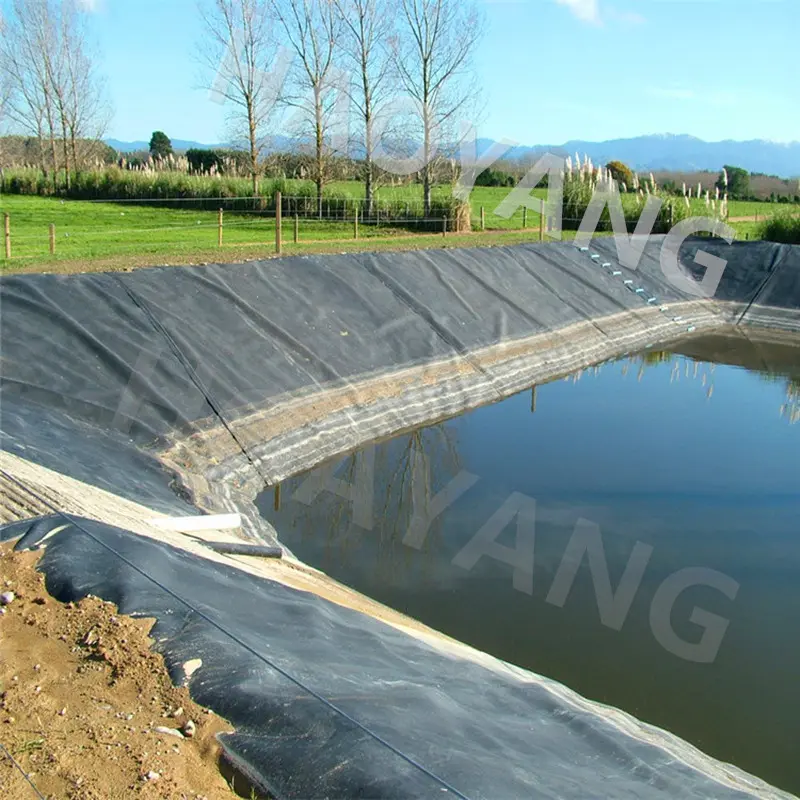Choosing the right geomembrane for your fish pond is a critical decision that impacts the pond's longevity, functionality, and environmental safety. Geomembranes act as liners, preventing water from seeping into the ground, thus maintaining the pond's water levels and integrity. This guide will help you understand the key factors to consider when selecting a geomembrane for your fish pond, ensuring that your choice supports a healthy and durable aquatic environment.
110484.webp)
1. Types of Geomembranes
There are several types of geomembranes available, each with distinct properties. The most common types include:
High-Density Polyethylene (HDPE): Known for its high strength, durability, and chemical resistance. It is widely used in large-scale pond projects.
Low-Density Polyethylene (LDPE): More flexible than HDPE, making it easier to handle and install. It is suitable for smaller ponds or intricate designs.
Ethylene Propylene Diene Monomer (EPDM): Highly flexible, UV resistant, and durable. It is an excellent choice for fish ponds due to its elasticity and ease of installation.
Polyvinyl Chloride (PVC): Flexible and relatively easy to install. However, it is less durable compared to HDPE and EPDM and may require more maintenance.
2. Thickness and Durability
The thickness of the geomembrane is a crucial factor that influences its durability and puncture resistance. Thicker membranes provide better protection against physical damage and are more durable. Common thicknesses for fish ponds range from 0.5mm to 1.5mm.
0.5mm (20 mil): Suitable for small decorative ponds with minimal physical stress.
0.75mm (30 mil): Offers moderate durability, ideal for medium-sized ponds.
1.0mm (40 mil): Provides excellent durability and is suitable for larger ponds with more significant physical stress.
1.5mm (60 mil): Used in large, heavily used ponds where maximum durability is required.
3. UV and Weather Resistance
Exposure to sunlight and varying weather conditions can degrade the geomembrane over time. UV-resistant geomembranes prevent damage caused by prolonged exposure to sunlight, ensuring the liner's longevity. EPDM and HDPE are particularly noted for their UV resistance.
4. Flexibility and Ease of Installation
The geomembrane's flexibility affects how easily it can be installed, especially in ponds with complex shapes or irregular surfaces. EPDM is highly flexible and easy to install, making it suitable for ponds with intricate designs. HDPE, while more rigid, can be challenging to install but offers superior durability for large, straightforward designs.
5. Environmental and Chemical Resistance
Fish ponds require geomembranes that are safe for aquatic life and resistant to various chemicals. The chosen geomembrane should not leach harmful substances into the water and should withstand exposure to fertilizers, pesticides, and other chemicals used in garden maintenance.
Fish Safety: Ensure the geomembrane is certified safe for aquatic life. EPDM and HDPE are commonly used in fish ponds due to their inert properties.
Chemical Resistance: HDPE is particularly resistant to a wide range of chemicals, making it a reliable choice for environments where chemical exposure is a concern.
6. Seamability and Repairs
Geomembranes need to be seamed together to cover large areas. The ease with which seams can be created and repaired is a critical factor.
Welding: HDPE and PVC membranes can be welded using heat, providing strong, durable seams.
Adhesives and Tapes: EPDM membranes are often seamed using adhesives or tapes, which can be easier to work with than welding but may not be as strong.
7. Cost Considerations
While cost should not be the sole deciding factor, it is essential to balance quality with budget constraints. HDPE tends to be less expensive than EPDM but may incur higher installation costs due to its rigidity. EPDM, though generally more expensive per square foot, can save on labor costs due to easier installation.
8. Longevity and Warranty
Investing in a geomembrane with a longer lifespan can provide better value over time. Manufacturers often provide warranties that give an indication of the expected durability. Look for geomembranes with warranties of 20 years or more.
Conclusion
Choosing the right geomembrane for your fish pond involves considering multiple factors, including material type, thickness, UV and chemical resistance, flexibility, cost, and longevity. Each type of geomembrane—HDPE, LDPE, EPDM, and PVC—has its advantages and is suited to different pond conditions and requirements.
For most fish ponds, EPDM and HDPE are the top choices due to their durability, flexibility, and environmental safety. EPDM is favored for its ease of installation and excellent UV resistance, making it ideal for ponds with complex designs. HDPE, with its superior strength and chemical resistance, is suitable for larger, simpler ponds that require long-term durability.
By carefully evaluating these factors and selecting a high-quality geomembrane, you can ensure the successful construction and maintenance of a fish pond that will remain a beautiful and healthy aquatic environment for years to come.
Our company has a comprehensive range of geomembranes tailored for your fish pond, encompassing HDPE, LDPE, EPDM, and PVC options. Each material is designed to meet your specific needs, ensuring durability and reliability. We invite you to inquire and place your order for a customized solution that perfectly suits your fish pond requirements.

897.webp)
942.webp)
237.webp)